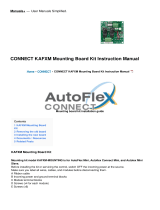
TABLE OF CONTENTS
0463 424 001 © ESAB AB 2018
1
READ THIS FIRST.................................................................................... 6
2
BEFORE STARTING SERVICE................................................................ 7
2.1 Service aid .............................................................................................. 7
2.2 ESAB Tools ............................................................................................. 7
3
INTRODUCTION....................................................................................... 8
3.1 Design structure of the power source.................................................. 8
3.2 Block diagram of ES 300i ...................................................................... 9
3.3 Block diagram of ET 300i/ET 300iP....................................................... 10
3.4 Circuit board positions .......................................................................... 11
3.5 Left and right sides of the power source ............................................. 11
4
WIRING DIAGRAM................................................................................... 12
4.1 Component description ......................................................................... 12
4.2 ES 300i, valid for serial no. 627-, 643-, 719-xxx-xxxx .......................... 14
4.3 ES 300i, valid for serial no. 725-, 742-xxx-xxxx ................................... 16
4.4 ES 300i, valid from serial no. 815-xxx-xxxx ......................................... 18
4.5 ET 300i and ET 300iP, valid for serial no. 721-, 742-xxx-xxxx............. 20
4.6 ET 300i and ET 300iP, valid from serial no. 815-xxx-xxxx................... 22
5
ERROR CODES........................................................................................ 24
5.1 Error code descriptions and service technician actions.................... 24
5.1.1 Err 1 – Temperature fault...................................................................... 24
5.1.2 Err 2 – Coolant fault ............................................................................. 25
5.1.3 Err 3 – Power supply fault .................................................................... 25
5.1.4 Err 4 – Communication fault................................................................. 26
5.1.5 Err 5 – Memory fault............................................................................. 26
5.1.6 Err 6 – Timing fault ............................................................................... 27
5.1.7 Err 7 – OCV fault .................................................................................. 27
5.1.8 Err 8 – Cooler hose disconnected ........................................................ 27
5.1.9 Measurement points and connectors on circuit boards........................ 28
6
TECHNICAL DATA ................................................................................... 29
7
SOFTWARE UPDATE AND CONFIGURATION....................................... 39
7.1 USB handling .......................................................................................... 39
7.1.1 Script files............................................................................................. 39
7.1.2 System software files ........................................................................... 39
7.2 Files location........................................................................................... 39
7.3 Application software update ................................................................. 40
7.3.1 Troubleshooting application software update ....................................... 40
7.4 Secondary bootloader update............................................................... 41
7.4.1 Troubleshooting secondary bootloader update .................................... 41
7.5 Software configuration .......................................................................... 42
7.5.1 Configuration of the power source according to product ordering
number .................................................................................................
42























